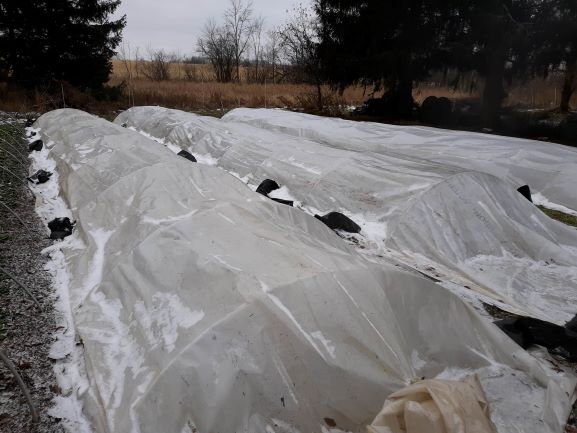 Above: Experimenting with overwintering spinach for spring harvest. It is seeded outdoors in late August. Once it gets really cold it is covered with hoops bent from 10' electrical conduit and a layer of greenhouse plastic- then held in place by sandbags until of course it just freeze to the ground. If all goes well the spinach will start growing again when we come out of our Persephone period-that is when we get more than 10 hours of daylight-something that happens on February 5th at our particular location on this planet we call earth. As December 31st draws near, I am getting ready to send out our first loan installment payments of our community loan project that include principal. We began 2019 with some very ambitious goals. With the funds you contributed, we set out to construct a second hoophouse, and complete a seedling greenhouse so that we would be able to distribute storage and fresh produce to our CSA members for 10 out of the 12 months of the year. Did we accomplish our goal? Yes and no. We were able to construct a second hoophouse and put the finishing touches on a much larger seedling/vegetable curing house. We also invested in irrigation equipment to be able to water our storage crops during the often dry months of July and August. These basic improvements, all funded by the loan project were necessary first steps to get us closer to meeting our goal of launching a spring share.
We got part way in setting up the old barn as an indoor space to pack shares. This space still needs to be insulated and finished-something we hope to work on this winter. One other challenge we need to address is that our current walk-in cooler is not attached to this space and so when temperatures are well below freezing, as they were this fall, we have logistical challenges of moving produce back and forth. We have also outgrown our current walk-in cooler—additional space is needed for our storage crops. Even with 15% losses of crops like carrots and potatoes from flooding this fall, our walk-in cooler was completely full to the ceiling just to satisfy our fall/winter members. In order to address these challenges our plan was and is to put a small attached addition on the barn that would have additional cooler space—we imagined the loan money would cover this and Jeff was ready to go—but supplies and labor for the first part of our project added up quickly and by August it became clear that the loan funds would be spent before we were able to tackle this leg of the project. We try not to make any big decisions in the middle of the season—and so tabled the financing of this portion of the project as something to tackle this winter so that we can continue working on the project during the 2020 growing season and hopefully be ready to launch a spring share by 2021. We do have some extra veggies in storage and are trialing more of Elliot Coleman’s over-wintering strategies this year. While we are not ready to launch shares, we may seek out a farmers market to attend this coming spring and will let you know if we will be in your neighborhood. We are ever so close to meeting our goal and will keep working toward it until it is realized. -Kelly
2 Comments
Hi-Tunnel Season Extension We now have a total of 300' x 34' of covered growing space at the farm. This is huge to extend the season in the spring and fall and also greatly increase our resiliency in unpredictable rain events. It also allows us to grow really high quality cucumbers and tomatoes and have them for a longer duration than would be typical in our area. Post Harvest Area We didn't quite get as far as we would have liked with the post-harvest area(before funds ran low). But even so, having an indoor space that we can heat will be huge this fall/winter when packing shares. This is an area in which we will continue to make progress this winter and next spring. Stay tuned. New Land Wow, Jeff tried a totally new growing system at the new land of 5' living lanes between each 500' single row of crops. We learned a lot this season and feel proud of what we've accomplished. It feels really good to transition 29 acres into organic bio-diverse agriculture. It has been incredible to see the land heal and life return. Also it has been amazing to bring people onto a piece of land that would have only seen large tractors for so long. Seedling Greenhouse/Curing House Now that we have the new greenhouse we cannot even imagine how we got by in an unheated space that was 1/10 the size. We are so glad to have Joseph's help again this year. He and Jeff worked together to get the cross-bracing on the new hi-tunnel last week. Standing in the bucket of the tractor is our substitute for a work platform. The house is tall, the metal is heavy and drilling screws into steel isn't my idea of fun...fortunately I didn't have to help because Jeff and Joseph work so well together!
--Kelly  We are delighted with the new seedling greenhouse. In past years we never had enough space for all our flats. This is a major improvement. We had a propane heater installed in late-February but hope to eventually get solar hot-water panels set up to water in pex tubing in the ground in at least part of the space. We also still need to insulate the perimeter where frost creeps in--but for now it is fully functional and a major improvement. Our tractor was 'in the shop' for over a month and so we were slowed down in our progress on the new hi-tunnel. Now that it is up and running thanks to Harvey Diversified Trade we were able to lift the arches onto the ground posts of the new hi-tunnel. The next step will be attach all the cross-bracing.
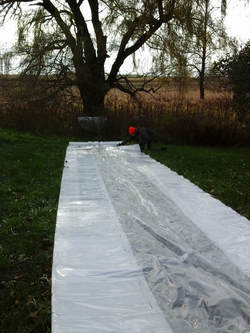 Measuring out the roll of plastic. We put two layers of plastic on and will inflate the space between with air to provide more insulation.  We tied a tennis ball in the plastic with a long rope and tossed it over the arch. We used the rope attached to the ball and plastic to stretch the plastic over the frame.  Jeff went up on the ladder to fasten the plastic into a track using wiggle wire.  We used a rigid corrugated plastic on the upper flat of the greenhouse in hopes it will shed snow better. Jeff could just barely reach to fasten it in place.  Here it is. We still need to level the ground around the base and install the heater. In the short term we will heat it with propane but hope to transition to using solar hot water in pex tubing. We are excited to design the internal layout of tables for seedlings and growing beds for winter greens this winter. Jeff will also use it as a warm work space during the winter.
We started building the new seedling greenhouse in 2014, but this is as far as we got before we put the project on hold. We considered moving and it wasn't until spring of 2018 that we renewed our interest in staying at our current farm. A huge part of this decision was securing access to additional farm land nearby through the Monarch Farms Project.
We started anew with the project in early September just after the heavy rains. We hired contractor Joseph Dittman, a real Renaissance man. He is a carpenter, pianist and farmer. He and Jeff worked together every Monday and Friday in September. Joseph was willing to use Jeff as his additional labor which helped us save money on this project.

Joseph came up with a custom design for the end walls and the two set to work framing them out.
They used lumber run perpendicular to the uprights to stabilize the arches.
They attached the doors to the frame and set to work cutting and fastening sheets of poly carbonate to the end walls. Joseph has left now to rebuild the inside of a Victorian home in Brattleboro, Vermont so it is up to Jeff and I to finish the project up. Stay tuned!
Our walk-in cooler needed a roof to keep it out of the elements. Jeff built the frame in June, but once CSA deliveries started he couldn't find the time to get the roof on...until one Sunday at the end of August he dusted off the stove top espresso maker and decided to get it done. We usually try to take Sunday off, but projects are starting to build up and winter is just around the corner...there was no better time to dust off the stove top espresso maker. 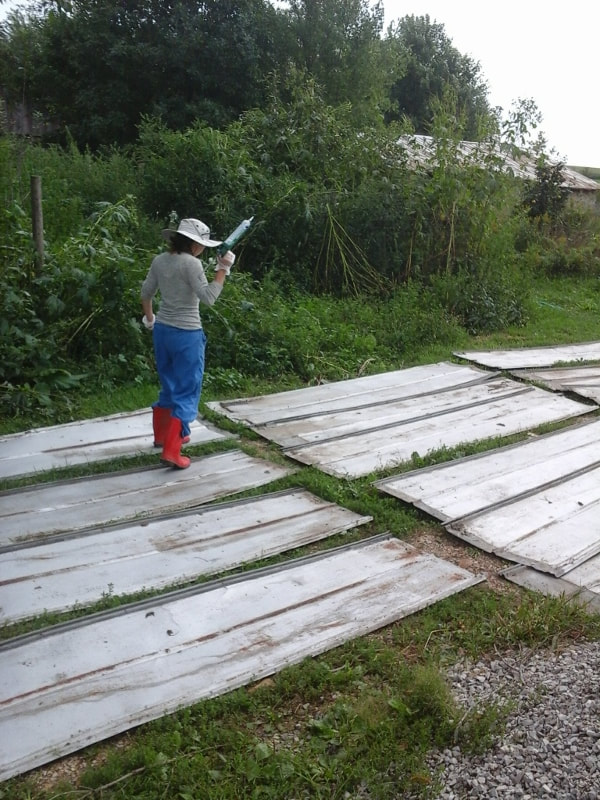
The price was right on this salvaged barn tin...free! Kelly's mom had it sitting in a pile for years and we asked really nicely and she gave it to us. It had holes in it that had to be sealed with silicone.
Getting the first few sheets of tin up is the hardest part. Once Jeff got in a rhythm it went pretty quick.
This video shows Jeff crawling around on the roof and putting screws through the tin into the lumber to hold it in place. Kelly is down below letting him know if he hit his mark.
First we had to move our tool shed because it was in the way of the path of the new electric line. We rolled it up onto round fence posts and Jeff pulled it with the tractor. It took us all morning to get it in place, but now it is much closer to the garden where we need all the tools anyway.  Next Jeff rented a mini-excavator and dug a two foot trench from the barn to the house. An electric line has to be buried at least two feet down to be up to code. This also took all day.  We had to dig the finishing touches of the trench in the areas near the building with shovels. And the poor electrician spent all afternoon chiseling away at the cement pad to break up enough area to run the wiring into the basement two feet down. We'd feel worse for him, but they make $67/hour and they charged us for 2 additional hours for this...so! You can see the yellow and black cord they laid in this picture. It was our job to back-fill the trench, and they instructed us not to put rocks back in the trench on top of the wire. 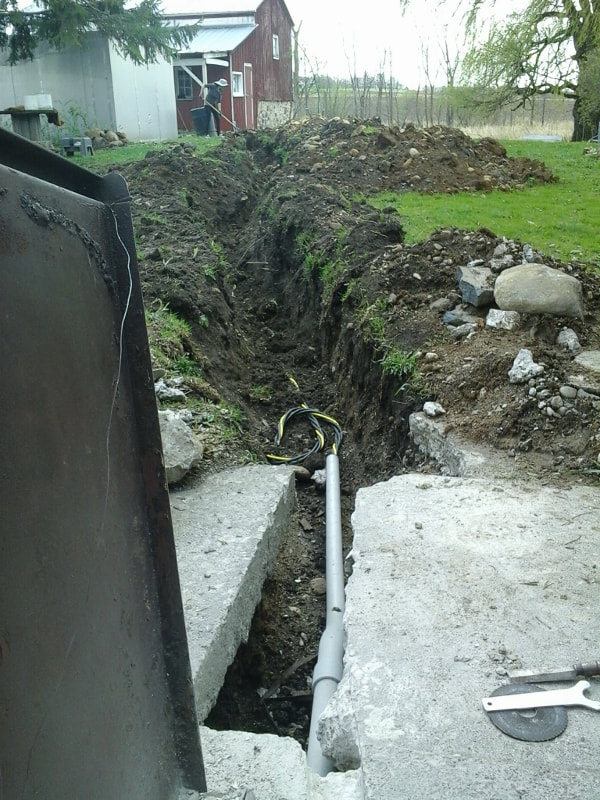 Next we used shovels to back-fill the trench with about a foot of soil. Then we put a 1 inch water line in the trench so that we will have 3 season water to the barn.  We seeded grass and it grew. We added our compost to the trench and some winter squash also grew in the lawn, but we moved them. Everything looks back to normal now and we have adequate electricity to the barn and walk in cooler plus a new waterline. 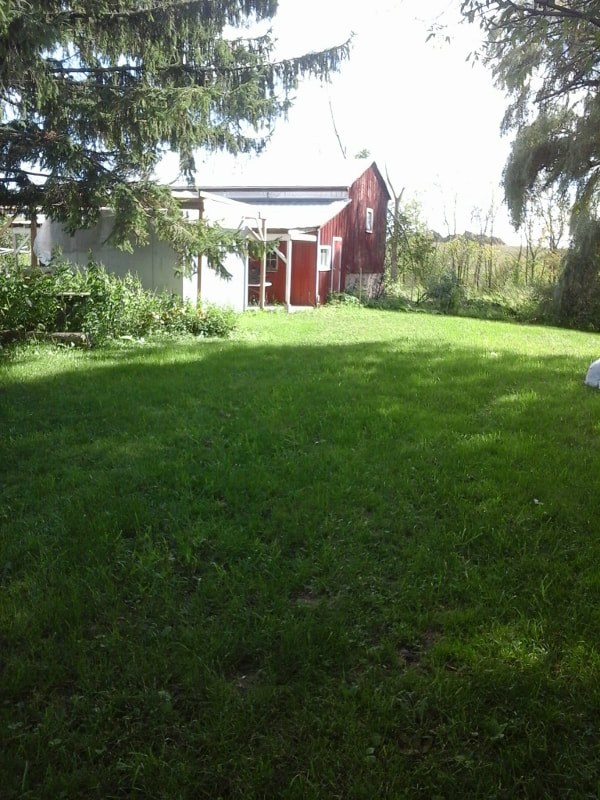 Jeff has been working to build a covering for our walk in cooler to keep it out of the elements. It will also provide storage space out of the rain on the adjacent side. We never seem to have enough of this! The roof will be salvaged barn tin. He's been trying for weeks to get the roof on, but the vegetables have been keeping us too busy. We'll be sure to post when he gets it finished. |
Archives
December 2019
Categories |
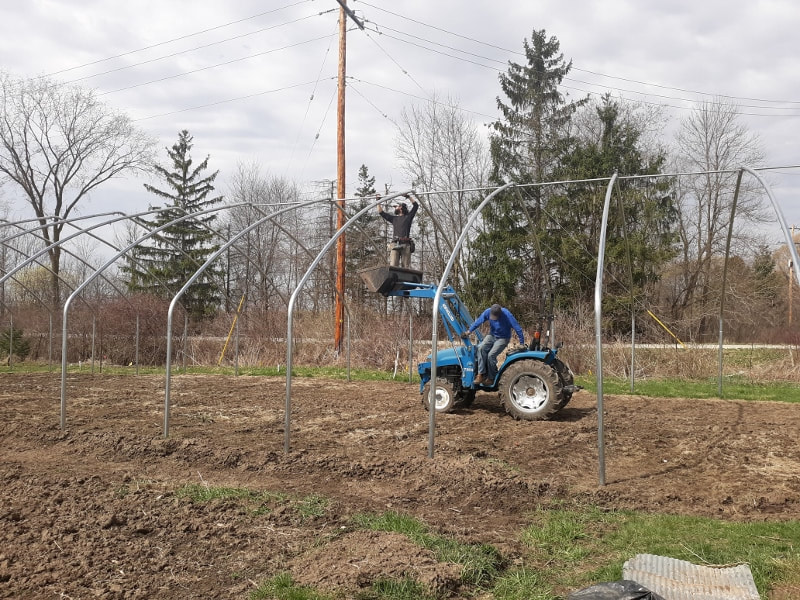
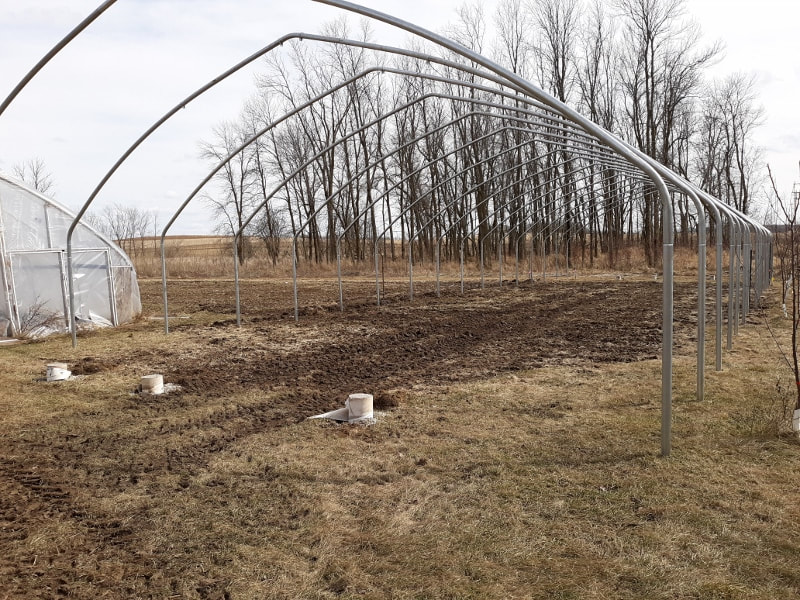





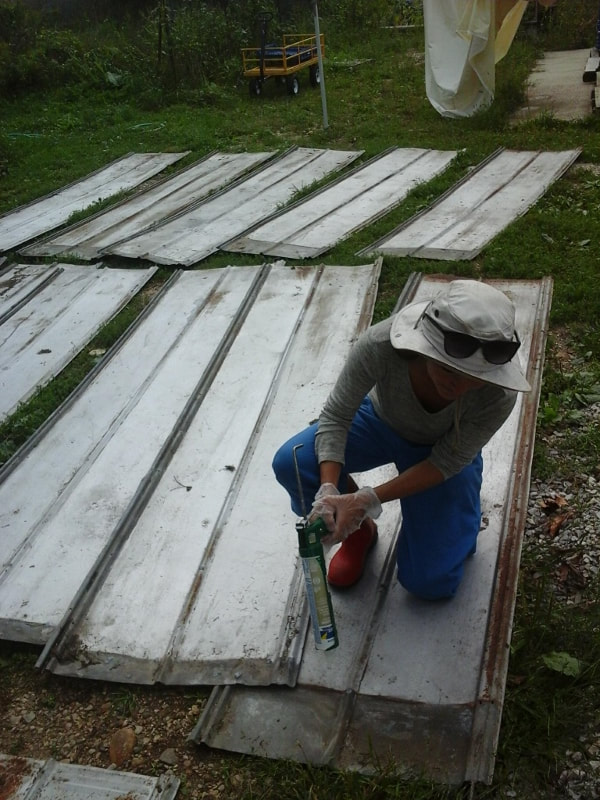
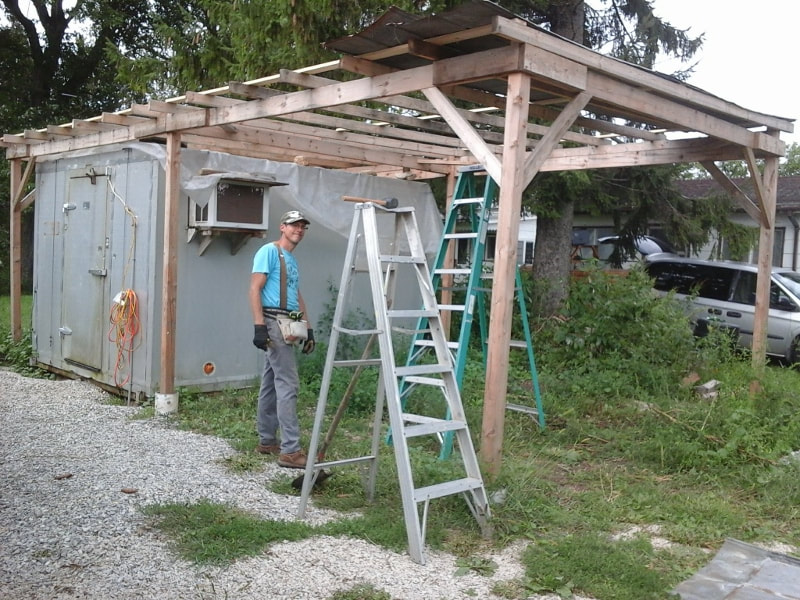
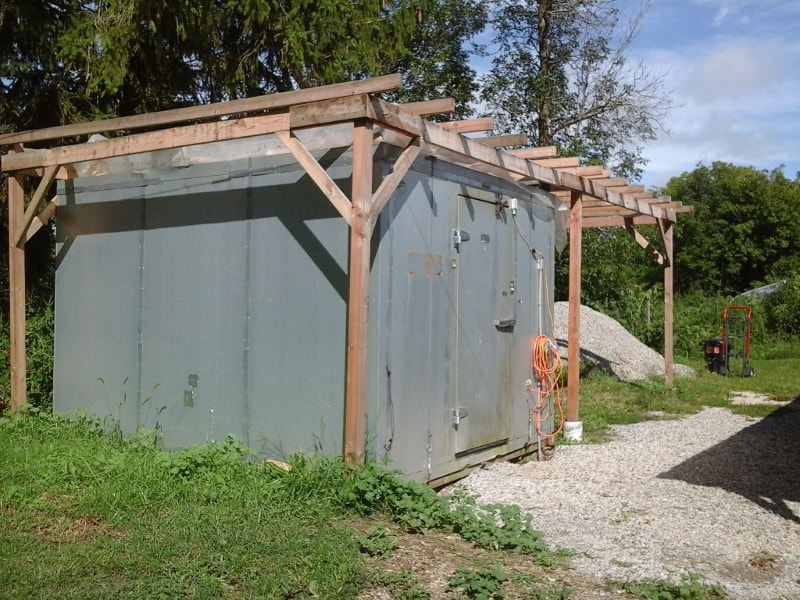
 RSS Feed
RSS Feed